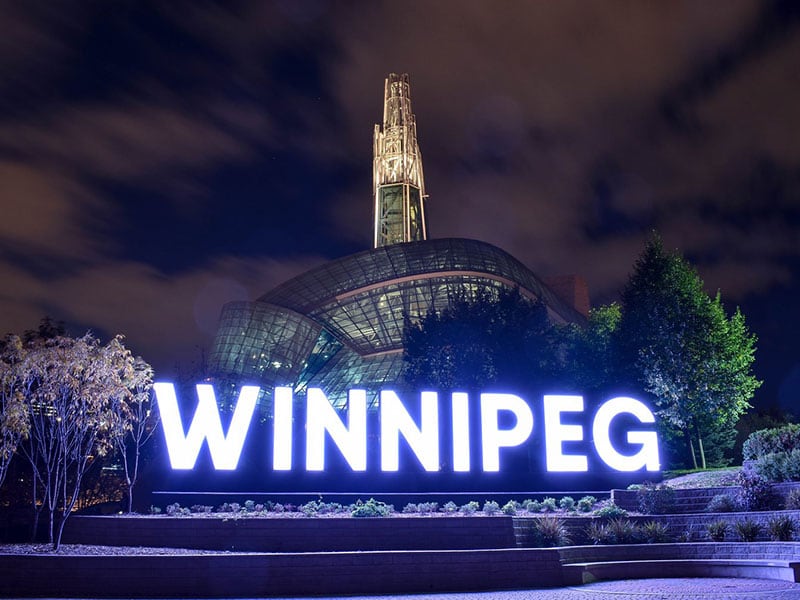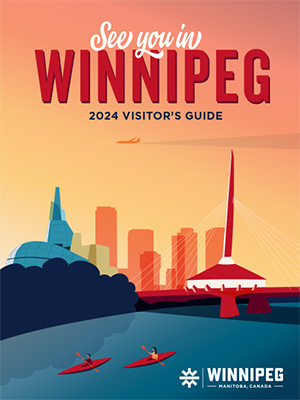Here you will find details on how to get here, how to get around, what you need to know about crossing the border, local weather and other helpful information to ensure you make the most of your trip.
How to get to Winnipeg
Winnipeg is the largest city and capital of Manitoba, located in the centre of Canada, and is accessible from almost anywhere in the world.
By Air
Winnipeg Richardson International Airport
2000 Wellington Avenue
P: (204) 987-9402
Winnipeg Richardson International Airport welcomes 4.3 million passengers annually. With over 140 flights per day, the airport is serviced by major and local carriers including Air Canada, United, Delta and WestJet.
Additional services are readily available through major charter operators or private air transportation facilities. The airport enjoys non-stop services from major U.S. hub airports: Atlanta, Chicago, Denver, Las Vegas, Minneapolis/St. Paul and more. Delta and United Airlines offer nearly 100 direct flights departing from Winnipeg each week.
For information on booking your flight to Winnipeg, visit the following passenger carrier links:
- Air Canada
- Air Transat
- Calm Air
- Delta Airlines
- Execaire
- Perimeter Aviation
- United Airlines
- WestJet Airlines
Other Passenger Carriers
For more information on flying to and from Winnipeg, including flight times, visit the Winnipeg Airports Authority website.
By Rail
VIA Rail
123 Main Street
Toll Free (Canada and U.S.): 1 (888) VIA-RAIL
The Canadian, one of VIA Rail’s proudest services, travels from Toronto to Vancouver with a stop in Winnipeg. For a one-of-a-kind experience, travel roundtrip from Winnipeg to Churchill, Manitoba, and experience the polar bear capital of the world.
VIA Rail Canada runs more than 480 trains per week over a 14,000-kilometre network, linking more than 450 localities in Canada. Over four million passengers travel on VIA Rail each year. You can connect to Via Rail through Amtrak or your local carrier.
For more information on booking your ticket, visit VIA Rail.
By Road
Winnipeg is an easy destination to get to, located one hour north of the U.S. border crossing at Pembina, North Dakota.
Within Canada:
- The No. 1 Trans-Canada Highway (east-west) provides direct connection to all major Canadian urban centres.
Connecting to the United States:
- Manitoba Hwy 75 South connects with U.S. Interstate 29 and Minnesota Interstate 94 (border crossing: Emerson).
- Manitoba Hwy 59 connects with Minnesota No. 59 and U.S. #2 (border crossing: Tolstoi).
Border Regulations
Travelling to Canada From the United States
The United States requires air travellers within North America to have passports or other secure, accepted documents to enter Canada, or to re-enter the United States. This policy also applies to Canadians travelling to and from these destinations.
Citizens travelling by land or sea, are required to have documents that comply with the Western Hemisphere Travel Initiative (WHTI). This includes a passport, a passport card, a trusted traveler card (NEXUS, SENTRI or FAST) or an enhanced driver's license.
U.S. residents are advised to visit the U.S. Department of State for the most up-to-date information.
Guests from other countries can visit the Government of Canada website for more information, or contact the Canadian embassy or consulate responsible for their region.
Within Canada, please visit Citizenship and Immigration Canada.
Returning to the United States
Upon your return to the U.S. from Canada, you may purchase and declare the following:
- $200 goods duty-free, after less than 48 hours.
- $800 goods duty-free, after more than 48 hours.
For more information on personal exemptions, please visit: https://www.cbp.gov/travel/international-visitors/kbyg/types-exemptions.
If you are travelling to Canada for business purposes, visit the business visitors site for more information.

